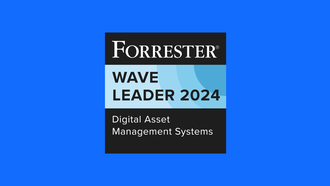In the ever-changing landscape of modern business, effective file management is a critical component of maintaining a competitive edge. As customers demand impeccable content experiences at every interaction, brands are tasked with creating, organizing, and distributing extensive amounts of content while striving to maintain a consistent presence across a multitude of channels.
However, the traditional methods of managing files using non-DAM solutions like Dropbox are no longer sufficient in today's digital-first world. This is where Bynder’s Digital Asset Management (DAM) system comes into play, offering a solution that goes beyond mere file storage. It serves as the central hub of your connected ecosystem, providing a reliable source for digital content throughout its entire lifecycle.
As more businesses look for platforms that help them gain a competitive edge, the limitations of some usual choices like Dropbox become clearer. To help you make the right decision for your organization, this article will cover the top Dropbox alternatives that your organization can consider, as well as dive into a detailed overview of Bynder’s DAM features and compare them against Dropbox's capabilities.
- What is Dropbox?
- What are the top Dropbox alternatives?
- Dropbox alternatives FAQs
- Wrapping up: Dropbox alternatives in 2024
What is Dropbox?
Dropbox is a cloud-based storage solution that allows you to share files, organize documents into folders, and collaborate with team members. As a popular storage service, users can access their files across multiple devices, thanks to the cloud. As a cloud-based solution, it also means users don’t need to use internal storage, making it easier to store and access large amounts of data and files. Dropbox is an agnostic platform, giving users the ability to access files in their Dropbox account from their desktop app, mobile app, or web browser, with any changes or updates to files being automatically synced.
Pros of Dropbox
As with any software, there are pros and cons to consider to ensure you’re choosing a storage solution that’s right for you. Some of the benefits of Dropbox include:
- Integrations: Dropbox offers a range of integrations with other third-party applications, allowing you to connect to the tools you use most.
- Collaboration features: With Dropbox, users can collaborate with one another by sharing folders, working on documents in real-time, and leaving comments on files.
- Ease of use: Dropbox has an intuitive interface that is straightforward and easy for users to start using the service with a limited learning curve.
Cons of Dropbox
While there are several advantages of using Dropbox, there are limitations that are worth noting, as they can impact your productivity and workflow. Some cons of Dropbox include:
- Limited search capabilities: For users with large amounts of files and data stored in their Dropbox accounts, searching for the files they need can be overwhelming, as Dropbox search functions are limited in scope, making it hard to find specific files.
- Security limitations: One of the drawbacks for some users is Dropbox’s security limitations that can put users’ files and information at risk. While Dropbox does have security features like multi-factor authentication and encryption protocols, more robust end-to-end encryption can ensure sensitive information is secure.
- Storage limitations: One of the top Dropbox concerns is the lack of storage for free users, meaning many have to upgrade to a paid plan for additional storage.
What are the top Dropbox alternatives?
There are several reasons why companies may turn to Dropbox for their storage needs. However, there are several drawbacks that may have you looking for Dropbox alternatives. Below are some of the top alternatives to Dropbox that may offer the solutions you need.
1. Bynder
Bynder is a digital asset management (DAM) platform that makes it easy to organize and share digital media assets and files. Bynder is one of the top Dropbox alternatives, and for good reason. With our DAM solution, your team can save time and money by ensuring seamless collaboration with peers, easy access and retrieval of files, and more. Here’s what makes us one of the best Dropbox alternatives:
Searchability
Dropbox relies on a traditional folder structure, which can get messy as your collection of files grows. Additionally, the absence of detailed metadata that caters to your business's unique needs makes finding the right files more difficult.
In contrast, Bynder provides AI-powered search and organization – a tailored taxonomy that allows for precise searches based on your organization's distinct requirements. This not only streamlines the search process but also ensures that files are organized in a way that aligns with your business goals.
Collaboration
Dropbox offers basic collaboration tools, which may fall short when dealing with larger teams collaborating on complex marketing projects. The lack of version control and real-time collaboration features can also lead to confusion and inefficiencies.
On the other hand, Bynder facilitates seamless sharing – secure sharing both within and outside the organization, including the ability to share collections of files efficiently. The best DAM solutions, like Bynder’s, offer workflow tools that automate and streamline the collaboration process—empowering distributed teams to get projects across the finish line faster.
Scalability
While Dropbox can integrate with different software platforms, it won’t sit at the heart of your company’s digital ecosystem—which can disrupt content management across the entire lifecycle. Comprehensive solutions should facilitate growth. However, Dropbox's storage limitations can hinder a company’s ability to create, manage, and distribute assets at scale—with a direct impact on a company’s ability to increase its visibility in a crowded marketplace.
Meanwhile, Bynder provides a tailored solution to current and future needs – with DAM at the center of their marketing stack, brands can shift their application architecture to an ecosystem of modular building blocks that can be composed based on current needs. A composable, integrated ecosystem can automate the delivery of content directly from one system of record to all content-serving platforms and adapt rapidly to changing contexts and needs.
Analytics
While Dropbox offers a basic file storage solution, it lacks the ability to provide insights into how your assets are performing, who is using them, and where they appear. Understanding which content resonates with your audience and drives engagement is crucial for refining your content strategy.
Conversely, Bynder guarantees: Proven ROI – A DAM solution like Bynder’s empowers teams with invaluable data, allowing marketers to track asset usage, view engagement metrics, and gain insights into which content is driving results. This way, you can accelerate user adoption and spot areas of improvement, maximize and prove the ROI of DAM, as well as audit and optimize asset usage to drive more engagement.
2. Google Workspace
Another Dropbox competitor is Google Workspace, which is an all-in-one workspace that gives users access to a variety of apps like Gmail, Google Drive, Google Docs, and more. Of the apps provided by Google Workspace, Google Drive is the primary competitor to Dropbox, as it’s a cloud-based storage solution that backs files up to the cloud and syncs them across devices. So what makes Google Workspace a top alternative to Dropbox? Let’s take a look.
Storage
While Dropbox only offers 2GB of storage to free users, Google Drive offers 15GB of free storage, which is shared across Gmail and Google Photos, which is Google’s photo management software tool. With more available storage space, small businesses can have the space they need to make tasks like content management and media asset management easy.
Security
Overall, Google Workspace has slightly more robust security measures compared to Dropbox, giving users peace of mind their assets and information are safe. While both Dropbox and Google encrypt data in transit and at rest, as well as offer multi-factor authentication through SMS, app, physical key, and phone call, Google encrypts your data using two keys instead of one, like Dropbox. Another security feature Google has over Dropbox is that users have the ability to encrypt their own files before uploading them to the cloud using a third-party plugin.
File search
Compared to Dropbox, Google Drive has a much more intuitive search feature that makes it easier to find the files and documents you’re looking for. Along with search chips that suggest documents in the search bar as you type, you can hone in on your search through Drive’s advanced search features.
3. Box
Box is another cloud storage service for businesses searching for a Dropbox alternative. What makes Box stand out is its primary focus on businesses and organizations rather than personal uses. Box users can access a built-in task manager, take notes on its note-taking app, and integrate with a wide range of apps, perfect for businesses using different types of tools.
Security
Because Box has a primary focus on businesses, it delivers enterprise-level security features that Dropbox users can’t access, such as granular permissions, user authentication with SSO and MFA, and vector-based watermarking. Box shares similar security features as Dropbox, but instills a zero-trust architecture approach that puts security at the forefront. Box is FIPS 140-2 certified, and each file stored in Box’s cloud-based platform uses AES 256-bit encryption in transit and at rest.
File sharing
Box has more accessible file-sharing capabilities compared to Dropbox. With Box, users can easily share zipped folders, raw videos, and other large files with a link, and recipients don’t need a Box account to access, download, and comment on the file.
Storage
Overall, Box’s free and business plans offer more storage compared to Dropbox, while Dropbox’s personal plans offer more storage. For example, Box’s free plan comes with 10GB of storage, whereas Dropbox offers free storage of up to 2GB.
4. Microsoft OneDrive for Business
Another comparable Dropbox competitor is Microsoft OneDrive, which is a cloud storage provider that offers many similar features as Dropbox. However, if your organization uses Office 365 apps and other Microsoft products, OneDrive is often the preferred choice, as it easily connects with many of Microsoft’s apps. Here are a few standouts that make Microsoft OneDrive for Business a top alternative to Dropbox.
Free plan
OneDrive’s free plan is more generous than the free plan offered by Dropbox. With OneDrive’s free plan, users can access 5GB of storage, compared to Dropbox’s 2GB. Additionally, while Dropbox has more plans with varying degrees of storage, OneDrive is better suited for businesses and teams with more than 15 people, has OneDrive gives each individual a certain amount of storage, depending on the plan, whereas Dropbox shares that storage across the entire team.
Admin controls
While Dropbox has more user-friendly admin controls, OneDrive gives admins access to a plethora of tools that make it easy to control governance and security features across a team. Because many OneDrive users have a Microsoft 365 subscription, they have access to more robust admin controls that can help bolster cybersecurity and IT efforts.
Dropbox Alternatives FAQs
What is the difference between Dropbox and DAM?
For many, Dropbox and DAM platforms might seem similar. However, there are stark differences that separate the two. To start, Dropbox is a cloud-based file-sharing service that makes it easy to store and share files. While it comes with some features to manage assets, cloud-based DAM, like Bynder, comes with more functionalities, such as the ability to tag images and files, create a tailored taxonomy, and access tools like brand templates that can be used to ensure consistency throughout your brand strategy.
What features does a cloud-based DAM solution have that Dropbox doesn’t?
One of the reasons you might be looking into Dropbox competitors is that Dropbox doesn’t offer all of the tools and features you need to ensure your team is productive. Below are some of the top features DAM solutions like Bynder offer that you can’t find with Dropbox:
- AI-powered search and organization: Customizable taxonomy for streamlined file retrieval.
- Bulk uploading and downloading: Save time with the ability to upload or download assets en masse.
- Seamless file-sharing: Secure sharing, including collections of files for bulk-sharing.
- Control access and usage rights: Protect confidentiality and prevent unapproved content from being published.
- Asset versioning: Users only have access to correct, up-to-date versions of assets.
- Asset detail overview: Centralized asset details and metadata.
- Integrations: Seamless integration with other platforms, ensuring that your DAM can evolve alongside your organization's technology stack, adapting to changing needs and staying aligned with your content strategy.
Along with these DAM features, there are additional functionalities that you can benefit from when using a Dropbox alternative like Bynder, such as:
- Automated asset optimization: Improved asset optimization for faster page loading times and better SEO.
- Built-in brand guidelines: Integrated brand guidelines within the DAM.
- Asset workflows: Manage, track, and collaborate on creative projects from start to finish.
- Built-in content creation tools: Scale and automate the creation of digital assets with editable templates.
How do you choose the best Dropbox alternative?
When looking into Dropbox alternatives, there are several factors to consider to ensure you make the right choice. Whether you’re looking for tools to help manage your image collection or a cloud DAM solution that makes it easy to retrieve, edit, and share files, some factors to consider include storage space, available integrations, safety and security, cost, and performance. Assessing these factors can help you find the right Dropbox alternative that meets the needs of your organization.
Wrapping up: Dropbox alternatives in 2024
In the rapidly evolving business landscape, overcoming the limitations of Dropbox for businesses is essential. Bynder’s DAM is the perfect Dropbox alternative as it not only addresses these limitations but also propels your organization toward greater efficiency and innovation. Embrace the future of content management and secure your competitive advantage—click below to find out more about Bynder’s outstanding features. In addition to our alternatives to Dropbox outlined in this guide, review our list of Brandfolder alternatives to find a DAM platform that works for you.












